Turbine pilot 2011 directory
Single-pilot stack up
With 2011 came a few rays of much-needed hope in the new light-jet and turboprop market segments. Inventories of used airplanes were on the decrease—traditionally a sign that prospective buyers will begin to consider buying new aircraft. But confidence remains shaken by the recession of 2008-2009, so many manufacturers have either cut back on their plans to introduce new designs or have delayed their previously scheduled certification and entry-into-service dates.
The recession forced some manufacturers into shelving their production plans, at least for now. These manufacturers aren't represented in this year's AOPA directory of single-pilot turbine airplanes. Meanwhile, companies such as Cirrus and Piper have been bought by foreign firms—a development that we hope will bring Cirrus' SF50 Vision and Piper's Altaire single-engine jets closer to fruition. Similarly, Eclipse Aerospace's injection of funding from Sikorsky Aircraft Corporation may produce the same outcome for Eclipse's 500. But the future of other designs—the Comp Air 12, the Swearingen SJ30-2, the Spectrums S-33 and S-40, and the Stratos 714—remains far murkier.
If there's an upside to the recession, it's that some manufacturers have used the time to invest in new-design development. So this year's directory shows Hawker Beechcraft Corporation's new King Air 250 (the replacement for the King Air B200GT), King Air 350i and 350iER (follow-ons of the previous King Air 350), and the Hawker 200 (the replacement for the Premier II). Other newly certified entries in this directory include Cessna's Citation CJ4, and the Embraer Phenom models 100 and 300.
Information for the directory entries is from company sources, and specifications are given for standard temperature and elevation conditions, unless otherwise noted. Maximum cruise speeds are given for optimum altitude and weight conditions, and maximum ranges are for full-fuel conditions. Information that was not available has been so noted.
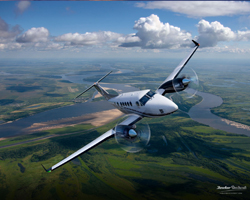 The new King Air 250 has a Rockwell Collins Pro Line 21 avionics suite plus 850-shp Pratt & Whitney PT6A-52 engines. Maximum cruise is 310 knots. The basic operating weight compared to the previous B200GT model is 355 pounds greater. Useful load decreased from 4,165 pounds for the now-replaced B200GT to 3,810 pounds for the King Air 250.
The new King Air 250 has a Rockwell Collins Pro Line 21 avionics suite plus 850-shp Pratt & Whitney PT6A-52 engines. Maximum cruise is 310 knots. The basic operating weight compared to the previous B200GT model is 355 pounds greater. Useful load decreased from 4,165 pounds for the now-replaced B200GT to 3,810 pounds for the King Air 250.
Beechcraft King Air 250
- Average-equipped price: $5.84 million
- Engines: Pratt & Whitney PT6A-52, 850 shp
- Length: 43 ft 10 in
- Height: 14 ft 10 in
- Wingspan: 57 ft 11 in
- Seats: 1 + 8 to 10
- Max cruise speed: 310 knots
- Typical high-speed cruise: 310 knots/750 lb hr @ FL260
- Range, four passengers: 1,074 nm
- Basic operating weight: 8,780 lb
- Max takeoff weight: 12,500 lb
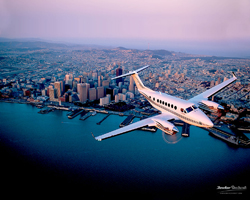 This newest variant of the very popular C90 series includes a Rockwell Collins Pro Line 21 avionics suite and 750-shp Pratt & Whitney PT6A-135A engines, flat-rated to 550 shp. The result is an airplane with a max cruise speed of 272 knots and a max range as far as 1,236 nm. The big news in this latest model is a 300-pound increase in payload with full fuel.
This newest variant of the very popular C90 series includes a Rockwell Collins Pro Line 21 avionics suite and 750-shp Pratt & Whitney PT6A-135A engines, flat-rated to 550 shp. The result is an airplane with a max cruise speed of 272 knots and a max range as far as 1,236 nm. The big news in this latest model is a 300-pound increase in payload with full fuel.
Beechcraft King Air C90GTx
- Average-equipped price: $3.77 million
- Engines: Pratt & Whitney PT6A-135A, 550 shp
- Length: 35 ft 6 in
- Height: 14 ft 3 in
- Wingspan: 53 ft 8 in
- Seats: 1 + 7 to 8
- Max cruise speed: 270 KTAS/612 lb hr
- Basic operating weight: 7,235 lb
- Max takeoff weight: 10,485 lb
- Usable fuel: 2,573 lb/384 gal
- Useful load: 3,310 lb
- Payload with full fuel: 737 lb
- Takeoff field length (50-foot obstacle): 2,552 ft (maximum takeoff weight)
- Landing distance at max landing weight: 2,363 ft
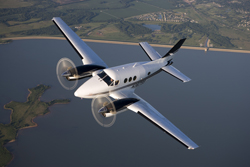 This is the top-of-the-line King Air, and it uses Rockwell Collins Pro Line 21 avionics. It is powered by two 1,050-shp Pratt & Whitney PT6A-60A engines and promises a typical high-speed cruise of 312 knots. If you need extended range or a high-performance special-mission aircraft, the King Air 350iER is available for $8.06 million, with a promised typical high-speed cruise of 303 knots.
This is the top-of-the-line King Air, and it uses Rockwell Collins Pro Line 21 avionics. It is powered by two 1,050-shp Pratt & Whitney PT6A-60A engines and promises a typical high-speed cruise of 312 knots. If you need extended range or a high-performance special-mission aircraft, the King Air 350iER is available for $8.06 million, with a promised typical high-speed cruise of 303 knots.
Beechcraft King Air 350i
- Average-equipped price: $7.04 million ($8.06 million for 350iER)
- Engines: Pratt & Whitney PT6A-60A, 1,050 shp
- Length: 46 ft 8 in
- Height: 14 ft 4 in
- Wingspan: 57 ft 11 in
- Seats: 1 + 9 to 11 (1+ 9 to 11 for 350iER)
- Max cruise speed: 313 KTAS (304 KTAS for 350iER)
- Long-range cruise speed: 235 KTAS
- Typical high-speed cruise: 312 KTAS (303 KTAS for 350iER)
- Range, four passengers: 1,535 nm (2,279 nm for 350iER)
- Basic operating weight: 10,000 lb (10,315 lb for 350iER)
- Max takeoff weight: 15,000 lb (16,500 lb for 350iER)
- Max fuel: 3,611 lb/539 gal (5,192 lb/775 gal for 350iER)
- Useful load: 5,100 lb (6,285 lb for 350iER)
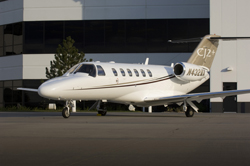 True to Cessna's Citation marketing strategy, the CJ2+ represents an incremental jump in performance over the now-out-of-production CJ1+. The CJ2+, with its more powerful engines, breaks the 400-knot cruise mark, is 30 knots faster than the CJ1+, and can fly 300 nautical miles farther. The CJ2+ cabin is three feet longer than that of the CJ1+.
True to Cessna's Citation marketing strategy, the CJ2+ represents an incremental jump in performance over the now-out-of-production CJ1+. The CJ2+, with its more powerful engines, breaks the 400-knot cruise mark, is 30 knots faster than the CJ1+, and can fly 300 nautical miles farther. The CJ2+ cabin is three feet longer than that of the CJ1+.
Cessna CJ2+
- Average-equipped price: $6.89 million
- Engines: Williams FJ44-3A-24, 2,490 lbst
- Length: 47 ft 8 in
- Height: 14 ft
- Wingspan: 49 ft 10 in
- Seats: 1+8/9
- Max cruise speed: 413 KTAS@FL350, 1,095 pph/163 gph
- Max NBAA IFR range: 1,610 nm
- Basic operating weight: 8,000 lb
- Max takeoff weight: 12,500 lb
- Max fuel: 3,930 lb/587 gals
- Useful load: 4,625 lb
- Payload with full fuel: 695 lb
- Takeoff field Length: 3,360 ft
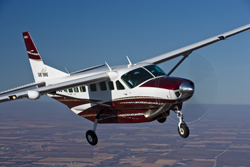 Cessna's Caravan was a big hit when it debuted in 1984. It has retained its popularity and Cessna has added more versions of the basic design—now known as the Model 675. Amphibious versions are available, as well as a luxury executive model (the Grand Caravan).
Cessna's Caravan was a big hit when it debuted in 1984. It has retained its popularity and Cessna has added more versions of the basic design—now known as the Model 675. Amphibious versions are available, as well as a luxury executive model (the Grand Caravan).
Cessna Caravan
- Average-equipped price: $2.1 million (675); $2.35 million (Amphibian); $2.16 million (Grand Caravan)
- Engine: Pratt & Whitney PT6A-114A, 675 shp
- Length: 38 ft 11 in (675 and Amphibian); 41 ft 7 in (Grand Caravan)
- Height: 15 ft 6 in (675 and Grand Caravan); 16 ft 4 in (Amphibian)
- Wingspan: 52 ft 1 in
- Seats: 8 (675 and Amphibian); 10 (Grand Caravan)
- Max cruise speed: 186 KTAS (675); 165 KTAS (Amphibian); 184 KTAS (Grand Caravan)
- Max NBAA IFR range: 949 nm (675); 822 nm (Amphibian); 917 nm (Grand Caravan)
- Basic operating weight: 4,740 lb (675); 5,610 lb (Amphibian); 5,080 lb (Grand Caravan)
- Max takeoff weight: 8,000 lb (675); 8,360 lb (Amphibian); 8,750 lb (Grand Caravan)
- Max fuel: 2,224 lb/332 gals
- Useful load: 3,295 lb (675); 2,785 lb (Amphibian); 3,705 lb (Grand Caravan)
- Payload with full fuel: 1,071 lb (675); 561 lb (Amphibian); 1,481 lb (Grand Caravan)
- Takeoff field Length: 2,055 ft (675); 3,280 ft (Amphibian); 2,420 ft (Grand Caravan)
- Landing distance: 1,625 ft (675); 2,045 ft (Amphibian); 1,795 ft (Grand Caravan)
 You say a CJ2+ can't carry enough to suit you? The CJ3, with a 1,100-pound greater useful load than the CJ2+, has up to 10 seats and still has cruise speeds similar to those of the CJ2+. And like the CJ2+, the CJ3 also has Rockwell Collins Pro Line 21 avionics.
You say a CJ2+ can't carry enough to suit you? The CJ3, with a 1,100-pound greater useful load than the CJ2+, has up to 10 seats and still has cruise speeds similar to those of the CJ2+. And like the CJ2+, the CJ3 also has Rockwell Collins Pro Line 21 avionics.
Cessna CJ3
- Average-equipped price: $8.15 million
- Engines: Williams FJ44-3A, 2,780 lbst
- Length: 51 ft 2 in
- Height: 15 ft 2 in
- Wingspan: 53 ft 4 in
- Seats: 1+8/9
- Max cruise speed: 415 KTAS @ FL330, 1,285 pph/191 gph
- Max NBAA IFR range: 1,873 nm
- Basic operating weight: 8,300 lb
- Max takeoff weight: 13,870 lb
- Max fuel: 4,710 lb/703 gals
- Useful load: 5,770 lb
- Payload with full fuel: 660 lb
- Takeoff field Length: 3,180 ft
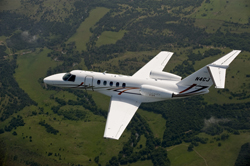 The CJ4 is the top of the CJ line and the latest of the CJs to be certified. Deliveries began in 2010. Thanks to its 3,400-lb-thrust engines and swept wings, the CJ4 surpasses the 417-knot max-cruise-speed barrier. Single-point refueling is standard, as is a new, lighter lithium-ion battery, a new entry-door design, four-panel spoilers, and a ground-spoiler feature.
The CJ4 is the top of the CJ line and the latest of the CJs to be certified. Deliveries began in 2010. Thanks to its 3,400-lb-thrust engines and swept wings, the CJ4 surpasses the 417-knot max-cruise-speed barrier. Single-point refueling is standard, as is a new, lighter lithium-ion battery, a new entry-door design, four-panel spoilers, and a ground-spoiler feature.
Cessna CJ4
- Average-equipped price: $9.06 million
- Engines: Williams FJ44-4A, 3,400 lbst
- Length: 53 ft 4 in
- Height: 15 ft 4 in
- Wingspan: 50 ft 10 in
- Seats: 1+7/8
- Max cruise speed: 445 KTAS @ FL370, 1,428 pph/213 gph
- Max NBAA IFR range: 2,030 nm
- Basic operating weight: 10,242 lb
- Max takeoff weight: 16,950 lb
- Max fuel: 5,828 lb/870 gals
- Useful load: 6,828 lb
- Payload with full fuel: 1,000 lb
- Takeoff field Length: 3,130 ft
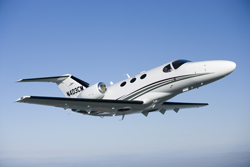 The Mustang is the lightest of the new generation of small, single-pilot very light jets. But Cessna would rather you call it a light-light jet. Either way, the Mustang has been a success, with more than 200 deliveries since its debut in 2007. It features the Garmin G1000 avionics suite, a max operating altitude of 41,000 feet, and a side-facing, non-belted lavatory seat.
The Mustang is the lightest of the new generation of small, single-pilot very light jets. But Cessna would rather you call it a light-light jet. Either way, the Mustang has been a success, with more than 200 deliveries since its debut in 2007. It features the Garmin G1000 avionics suite, a max operating altitude of 41,000 feet, and a side-facing, non-belted lavatory seat.
Cessna Citation Mustang
- Average-equipped price: $3.07 million
- Engines: Pratt & Whitney PW615F, 1,460 lbst
- Length: 40 ft 7 in
- Height: 13 ft 5 in
- Wingspan: 43 ft 2 in
- Seats: 1+5
- Max cruise speed: 339 KTAS@FL350, 609 pph/91 gph
- Max NBAA IFR range: 1,159 nm
- Basic operating weight: 5,350 lb
- Max takeoff weight: 8,645 lb
- Max fuel: 2,580 lb/385 gals
- Useful load: 3,170 lb
- Payload with full fuel: 590 lb
- Takeoff field Length: 3,110 ft
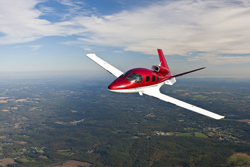 A certification test article of the SF50 single-engine jet has been flying since 2008, but there is uncertainty in the program's future. But there are more than 400 deposit holders for the new V-tail jet, and Cirrus says that certification of the SF50 remains its number-one engineering program. The airplane will have the Garmin G3000 flight deck as its avionics suite.
A certification test article of the SF50 single-engine jet has been flying since 2008, but there is uncertainty in the program's future. But there are more than 400 deposit holders for the new V-tail jet, and Cirrus says that certification of the SF50 remains its number-one engineering program. The airplane will have the Garmin G3000 flight deck as its avionics suite.
Cirrus Vision SF50 (under certification)
- Average-equipped price: $1.72 million
- Engines: Williams FJ33-5A, 1,900 lbst
- Length: 30 ft 9 in
- Height: 10 ft 6 in
- Wingspan: 38 ft 4 in
- Seats: 1+3/6
- Max cruise speed: 300 KTAS @FL280, 450 pph/67 gph
- Max NBAA IFR range: 1,000 nm
- Basic operating weight: 3,700 lb
- Max takeoff weight: 6,000 lb
- Max fuel: 1,900 lb/284 gals
- Useful load: 2,300 lb
- Payload with full fuel: 400 lb
- Takeoff field Length: 2,128 ft
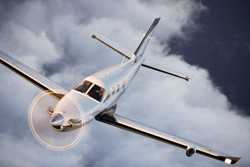 Daher-Socata officials position the TBM 850 as having jet speeds (320 KTAS) with the lower operating costs typical of a turboprop. It is claimed to climb to 31,000 feet in 20 minutes and fl y 1,400 nm at economy settings, yet use a 2,100-foot runway—shorter when propeller reverse is applied. It comes standard with Garmin G1000 integrated avionics.
Daher-Socata officials position the TBM 850 as having jet speeds (320 KTAS) with the lower operating costs typical of a turboprop. It is claimed to climb to 31,000 feet in 20 minutes and fl y 1,400 nm at economy settings, yet use a 2,100-foot runway—shorter when propeller reverse is applied. It comes standard with Garmin G1000 integrated avionics.
Daher-Socata TBM 850
- Average-equipped price: $3.29 million
- Engines: Pratt & Whitney PT6A-66D, 850 shp at 2,000 rpm
- Length: 34 ft 11 in
- Height: 14 ft 3 in
- Wingspan: 41 ft 7 in
- Seats: 6 (including pilot)
- Max cruise speed: 320 KTAS @ FL260/441 pph/65 gph
- Range at maximum cruise (320 KTAS): 1,290 nm (45 min reserve, four adults on board)
- Basic operating weight: 4,589
- Max takeoff weight: 7,394 lb
- Usable fuel: 1,985 lb/292 gal
- Useful load: 2,632 lb
- Payload with full fuel: 647
- Takeoff over 50-foot obstacle: 2,840 ft (MGTOW @sea level, std conditions)
- Landing distance without reverser: 2,430 ft
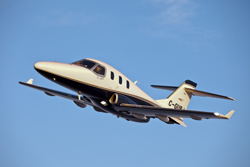 The D-JET is among the easiest to operate of the VLJ designs, with its single turbofan engine and 25,000-foot max operating altitude. Its 5,690-pound max ramp weight also makes it the lightest of the light jets. The cockpit is centered around the three-screen Garmin G1000 avionics suite. It has been in development since 2007, and certification is expected in late 2012.
The D-JET is among the easiest to operate of the VLJ designs, with its single turbofan engine and 25,000-foot max operating altitude. Its 5,690-pound max ramp weight also makes it the lightest of the light jets. The cockpit is centered around the three-screen Garmin G1000 avionics suite. It has been in development since 2007, and certification is expected in late 2012.
Diamond D-JET (under certification)
- Average-equipped price: $1.85 million
- Engines: Williams FJ33-5, 1,700 lbst
- Length: 35 ft 1 in
- Height: 11 ft 7 in
- Wingspan: 37 ft 6 in
- Seats: 1+4
- Max cruise speed: 315 KTAS @FL250
- Max NBAA IFR range: 1,200 nm
- Basic operating weight: 3,450 lb
- Max takeoff weight: 5,650 lb
- Max fuel: 1,740 lb/260 gals
- Useful load: 2,240 lb
- Payload with full fuel: 500 lb
- Takeoff field Length: 2,500 ft
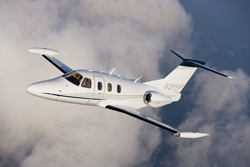 Eclipse Aviation created the concept of the VLJ with the development of its Eclipse 500, which went to market in 2007. The airplane was a sales success, with some 260 units delivered. In February 2011 Sikorsky Aircraft Corp. bought into the Eclipse, inspiring some to predict production could by late 2011. Total Eclipse upgrades of the original models are for sale now.
Eclipse Aviation created the concept of the VLJ with the development of its Eclipse 500, which went to market in 2007. The airplane was a sales success, with some 260 units delivered. In February 2011 Sikorsky Aircraft Corp. bought into the Eclipse, inspiring some to predict production could by late 2011. Total Eclipse upgrades of the original models are for sale now.
Eclipse 500
- Average-equipped price: $2.15 million
- Engines: Pratt & Whitney PW610F-A, 1,200 lbst
- Length: 33 ft 6 in
- Height: 11 ft
- Wingspan: 37 ft 11 in
- Seats: 1+5
- Max cruise speed: 370 KTAS @ FL410, 400 pph/60 gph
- Max NBAA IFR range: 1,125 nm
- Basic operating weight: 3,834 lb
- Max takeoff weight: 6,000 lb
- Max fuel: 1,698 lb/251 gal
- Useful load: 2,400 lb
- Payload with full fuel: 502 lb
- Takeoff field Length: 2,394 ft
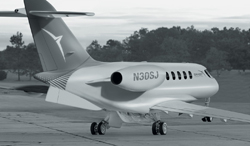 Development of the Emivest Aerospace SJ30-2 is a 20-year saga that spans three continents, millions of dollars in costs, and multiple changes in corporate ownership and bankruptcies (see " Trials and Travails of the SJ30," January 2011 Turbine Pilot). But the SJ30-2's performance has never been in dispute: It offers stunning speed and range at altitudes up to 49,000 feet.
Development of the Emivest Aerospace SJ30-2 is a 20-year saga that spans three continents, millions of dollars in costs, and multiple changes in corporate ownership and bankruptcies (see " Trials and Travails of the SJ30," January 2011 Turbine Pilot). But the SJ30-2's performance has never been in dispute: It offers stunning speed and range at altitudes up to 49,000 feet.
Emivest SJ30-2
- Average-equipped price: $7.2 million
- Engines: Williams FJ44-2A; 2,300 lbst each
- Length: 46.9 feet
- Height: 15.56 feet
- Wingspan: 42.33 feet
- Seats: 1+6
- Max cruise speed: 486 KTAS
- Max Range: 2,500 nm
- Basic operating weight: 8,650 lb
- Max takeoff weight: 13,950 lb
- Max fuel: 4,850 lb/723 gals
- Useful load: 5,400 lb
- Payload with full fuel: 550 lb
- Takeoff field Length: 3,939 ft (balanced field)
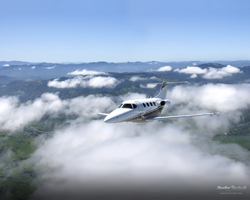 With a max cruise speed of 454 knots, the Beechcraft Premier 1A is the fastest of the single-pilot jets. It features swept wings, a composite-construction fuselage, and Rockwell Collins Pro Line 21 avionics. The airplane's comparatively large cabin dimensions and a lift-dump system that uses a maximum flap deflection to assist in braking after touchdown are notable.
With a max cruise speed of 454 knots, the Beechcraft Premier 1A is the fastest of the single-pilot jets. It features swept wings, a composite-construction fuselage, and Rockwell Collins Pro Line 21 avionics. The airplane's comparatively large cabin dimensions and a lift-dump system that uses a maximum flap deflection to assist in braking after touchdown are notable.
Hawker Beechcraft Premier 1A
- Average-equipped price: $6.9 million
- Engines: Williams FJ44-2A, 2,300 lbst
- Length: 46 ft
- Height: 15 ft 4 in
- Wingspan: 44 ft 6 in
- Seats: 1+6/7
- Max cruise speed: 454 KTAS @ FL330, 1,203 pph/180 gph
- Max NBAA IFR range: 1,453 nm
- Basic operating weight: 8,600 lb
- Max takeoff weight: 12,500 lb
- Max fuel: 3,670 lb/548 gals
- Useful load: 4,040 lb
- Payload with full fuel: 370 lb
- Takeoff field Length: 3,792 ft
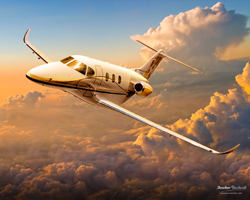 Introduced at the 2010 NBAA convention, the Hawker 200 will be the replacement design for Hawker Beechcraft's proposed Premier II. The airplane will have winglets, a new variant of the Williams FJ44 engine, a 10-year warranty, and 400-hour inspection intervals. The Hawker 200 will have a composite fuselage and aluminum wings. Entry into service is set for 2012.
Introduced at the 2010 NBAA convention, the Hawker 200 will be the replacement design for Hawker Beechcraft's proposed Premier II. The airplane will have winglets, a new variant of the Williams FJ44 engine, a 10-year warranty, and 400-hour inspection intervals. The Hawker 200 will have a composite fuselage and aluminum wings. Entry into service is set for 2012.
Hawker 200 (under certification)
- Average-equipped price: $7.495 million
- Engines: Williams FJ44-3AP, 3,000 lbst
- Length: 46 ft
- Height: 15 ft 4 in
- Wingspan: 45 ft 7 in
- Seats: 1+6/7
- Max cruise speed: 473 KTAS
- Max NBAA IFR range: 1,530 nm
- Basic operating weight: 9,320 lb
- Max takeoff weight: 13,800 lb
- Max fuel: 3,650 lb/545 gals
- Useful load: 4,580 lb
- Payload with full fuel: 930 lb
- Takeoff field Length: 3,720 ft
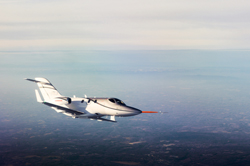 Honda has taken a patient, innovative approach to its first foray into the GA marketplace with a twinjet that uses over-wing engine pylons, composite materials, and an engine developed with General Electric. The first HondaJet flew in 2003, and conforming prototypes have turned in exceptional performance in speed and efficiency at altitudes up to 43,000 feet.
Honda has taken a patient, innovative approach to its first foray into the GA marketplace with a twinjet that uses over-wing engine pylons, composite materials, and an engine developed with General Electric. The first HondaJet flew in 2003, and conforming prototypes have turned in exceptional performance in speed and efficiency at altitudes up to 43,000 feet.
HondaJet (under certification)
- Average-equipped price: $3.65 million in 2006
- Engine: GE Honda HF120; 1,880 lbst
- Length: 41 ft 8 in
- Height: 13 ft 3 in
- Wingspan: 39 ft 10 in
- Seats: 1+5
- Max cruise speed: 420 KTAS @ FL300
- Max demonstrated: 425 KTAS @ 30,000 ft
- Max IFR range: 1,180 nm
- Basic operating weight: NA
- Max takeoff weight: 9,200 lb
- Max fuel: NA
- Useful load: NA
- Payload with full fuel: NA
- Takeoff field Length: 3,120 ft
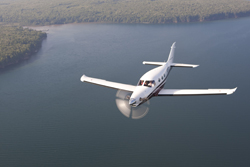 The all-composite Kestrel is meant to fit into the single-engine turboprop marketplace somewhere between the TBM 850 and the Pilatus PC–12. With its six to eight seats, a 325-knot cruise, and target price of $3 million, CEO Alan Klapmeier says he expects to sell and produce 75 new airplanes a year.
The all-composite Kestrel is meant to fit into the single-engine turboprop marketplace somewhere between the TBM 850 and the Pilatus PC–12. With its six to eight seats, a 325-knot cruise, and target price of $3 million, CEO Alan Klapmeier says he expects to sell and produce 75 new airplanes a year.
Kestrel (in development)
- Average-equipped price: $3 million
- Engine: PT6A-67A for prototype
- Length: 37 ft 4 in
- Height: 12 ft 6 in
- Wingspan: 43 ft
- Seats: 6-8
- Final Kestrel specifications and its target certification date have not been set.
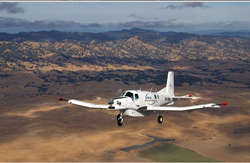 This all-metal, fixed-gear utility plane built in New Zealand by Pacific Aerospace Ltd. was originally developed to haul skydivers but also is marketed as a utility aircraft. It was certified in the United States in 2004 and carries a single pilot and up to nine passengers. The aircraft has a range of 582 nm.
This all-metal, fixed-gear utility plane built in New Zealand by Pacific Aerospace Ltd. was originally developed to haul skydivers but also is marketed as a utility aircraft. It was certified in the United States in 2004 and carries a single pilot and up to nine passengers. The aircraft has a range of 582 nm.
P-750 XSTOL
- Average-equipped price: $1.65 million
- Engines: Pratt & Whitney PT6A-34, 750 shp
- Length: 36 ft 6 in
- Height: 13 ft 2 in
- Wingspan: 42 ft
- Seats: 1 + 9
- Max cruise speed: 168 KTAS (162 KTAS with cargo pod), 335lb/50 gph
- Basic operating weight: 3,300 lb
- Max takeoff weight: 7,500 lb
- Fuel: 1,481 lb/221 gal
- Useful load: 4,200 lb
- Payload with full fuel: 2,719 lb
- Takeoff over 50-foot obstacle: 1,196 ft @ 7,500 lb
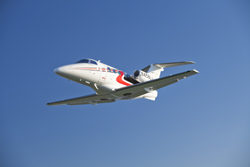 Embraer made a big splash in 2008 when it entered the business-jet market with its Phenom 100 entry-level light jet. The Phenom 100 has the Embraer-specified Prodigy glass cockpit, a three-screen Garmin G1000 system tailored to show system information and synoptics on its multifunction display. Deliveries passed the 100 mark just two years after its introduction.
Embraer made a big splash in 2008 when it entered the business-jet market with its Phenom 100 entry-level light jet. The Phenom 100 has the Embraer-specified Prodigy glass cockpit, a three-screen Garmin G1000 system tailored to show system information and synoptics on its multifunction display. Deliveries passed the 100 mark just two years after its introduction.
Phenom 100
- Average-equipped price: $3.745 million
- Engines: Pratt & Whitney PW617F, 1,695 lbst
- Length: 42 ft 1 in
- Height: 14 ft 3 in
- Wingspan: 40 ft 4 in
- Seats: 1 + 6/7
- Max cruise speed/fuel burn: 390 KTAS @ FL330, 852 pph/127 gph
- Max NBAA IFR range: 1,196 nm
- Basic operating weight: 7,132 lb
- Max takeoff weight: 10,472 lb
- Max fuel: 2,804 lb/419 gals
- Useful load: 3,384 lb
- Payload with full fuel: 580 lb
- Takeoff field Length: 3,125 ft
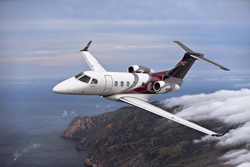 The Brazilian-built Phenom 300 is the Phenom 100's bigger brother. The 300 features slightly swept wings and 440-knot max cruise speeds, and it shares the 100's three-screen Garmin G1000-based Prodigy avionics suite. The popular Phenom 300 is a direct competitor of Cessna's CJ4—which has virtually identical performance specifications, but at about $1 million less.
The Brazilian-built Phenom 300 is the Phenom 100's bigger brother. The 300 features slightly swept wings and 440-knot max cruise speeds, and it shares the 100's three-screen Garmin G1000-based Prodigy avionics suite. The popular Phenom 300 is a direct competitor of Cessna's CJ4—which has virtually identical performance specifications, but at about $1 million less.
Phenom 300
- Average-equipped price: $8.14 million
- Engines: Pratt & Whitney PW535E, 3,360 lbst
- Length: 52 ft 1 in
- Height: 16 ft 4 in
- Wingspan: 52 ft 2 in
- Seats: 1 + 7/9
- Max cruise speed: 444 KTAS @ FL350, 1,312 pph/195 gph
- Max NBAA IFR range: 1,964 nm
- Basic operating weight: 11,583 lb
- Max takeoff weight: 17,968 lb
- Max fuel: 5,403 lb/806 gals
- Max Useful load: 6,495 lb
- Payload with full fuel: 1,142 lb
- Takeoff field Length: 3,138 ft
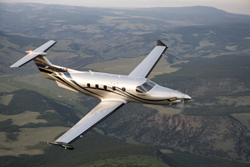 PC–12s are big-cabin load-haulers par excellence, and most are ordered with a stylish seven-seat interior designed by BMW DesignWorks USA. The airplane features a single 1,200-shp Pratt & Whitney PT6A-67P engine, a forward air stair door, and a huge aft cargo door that is remotely operated.
PC–12s are big-cabin load-haulers par excellence, and most are ordered with a stylish seven-seat interior designed by BMW DesignWorks USA. The airplane features a single 1,200-shp Pratt & Whitney PT6A-67P engine, a forward air stair door, and a huge aft cargo door that is remotely operated.
Pilatus PC–12 NG
- Average-equipped price: $4.37 million
- Base price: $3.87 million
- Engine: Pratt & Whitney PT6A-67A, 1,200 shp @ 1,700 rpm
- Length: 47 ft 3 in
- Height: 14 ft
- Wingspan: 53 ft 3 in
- Seats: 1 + 10, 1 +9
- Max cruise speed: 280 KTAS
- Max IFR range w/NBAA reserves: 1,560 nm (3 passengers, 30,000 ft)
- Basic operating weight (includes 200 lb pilot): 6,782 lb
- Max takeoff weight: 10,450 lb
- Usable fuel: 2,704 lb/402 gal
- Useful load: 3,713 lb
- Payload with full fuel and 200-lb pilot: 1,009 lb
- Takeoff over 50-foot obstacle: 2,650 ft
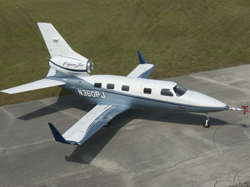 Piper Aircraft has rebranded the PiperJet "Altaire" and made design changes, including a larger cabin, longer wing, and shortened vertical tail. The PiperJet logged more than 400 flight-test hours and pioneered an automated trim system designed to adjust for power changes in the single tail-mounted engine. Customer deliveries are scheduled to begin in 2014.
Piper Aircraft has rebranded the PiperJet "Altaire" and made design changes, including a larger cabin, longer wing, and shortened vertical tail. The PiperJet logged more than 400 flight-test hours and pioneered an automated trim system designed to adjust for power changes in the single tail-mounted engine. Customer deliveries are scheduled to begin in 2014.
PiperJet Altaire (under certification)
- Average-equipped price: $2.5 million
- Engine: Williams FJ44-3AP, 2,500 lbst
- Length: 37 ft 6 in
- Height: 15 ft 7 in
- Wingspan: 44 ft 5 in
- Seats: 1 + 5
- Max cruise speed: 360 KTAS
- Max range: 1,300 nm
- Basic operating weight: NA
- Max takeoff weight: 9,200 lb
- Max fuel: 3,060 lb/457 gal
- Payload with full fuel: 800 lb
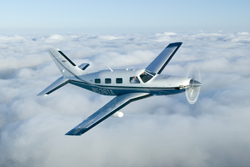 The turboprop Piper Meridian has become a mainstay of the Piper fleet despite competition from VLJs and turbocharged pistons. The six-seat Meridian with its 500-horsepower PT6A-42A can reach 30,000 feet (limited to 28,000 in RVSM airspace), several thousand feet above high-performance pistons. The Meridian is equipped with the Garmin G1000 avionics suite.
The turboprop Piper Meridian has become a mainstay of the Piper fleet despite competition from VLJs and turbocharged pistons. The six-seat Meridian with its 500-horsepower PT6A-42A can reach 30,000 feet (limited to 28,000 in RVSM airspace), several thousand feet above high-performance pistons. The Meridian is equipped with the Garmin G1000 avionics suite.
Piper Meridian
- Average-equipped price: $2.07 million
- Engine: Pratt & Whitney PT6A-42A, 500 shp
- Length: 29 ft 7 in
- Height: 11 ft 4 in
- Wingspan: 43 ft
- Seats: 1 + 5
- Max cruise speed: 260 KTAS
- Range with 45 min reserve: 1,000 nm
- Basic operating weight: 3,433 lb
- Max takeoff weight: 5,092 lb
- Usable fuel: 1,139 lb/170 gal
- Useful load: 1,701 lb
- Payload with full fuel: 562 lb
- Takeoff over 50-foot obstacle: 2,438 ft
 The Quest Kodiak was developed specifically for missionary operations to unimproved runways. The utility aircraft has a Garmin G1000 glass cockpit and can cover more than 1,000 nm with IFR fuel reserves at cruise speeds up to 183 KTAS. It is powered by a Pratt & Whitney PT6A-34 and can be adapted to a wide variety of cargo and passenger configurations.
The Quest Kodiak was developed specifically for missionary operations to unimproved runways. The utility aircraft has a Garmin G1000 glass cockpit and can cover more than 1,000 nm with IFR fuel reserves at cruise speeds up to 183 KTAS. It is powered by a Pratt & Whitney PT6A-34 and can be adapted to a wide variety of cargo and passenger configurations.
Quest Kodiak
- Average-equipped price: $1.67 million
- Engines: Pratt & Whitney PT6A-34, 750 shp @ 2,200 rpm
- Length: 34 ft 3 in
- Height: 14 ft 9 in
- Wingspan: 45 ft
- Seats: 1 + 9
- Max cruise speed: 175 KTAS, 12,000 ft, 50 gph, 974 nm, 5.5 hr
- Max range: 1,113 nm at 137 KTAS, 12,000 ft, 34 gph, 8.1 hr
- Basic empty weight: 3,770 lb
- Max takeoff weight: 7,255 lb
- Usable fuel: 2,176 lb/320 gal
- Useful load: 3,535 lb
- Payload with full fuel: 1,387 lb
- Takeoff over 50-foot obstacle: 1,468 ft
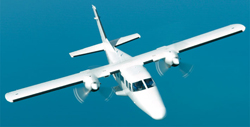 The A-Viator is a multipurpose, high-wing turboprop twin with entry-level simplicity. A large, unpressurized cabin can be configured for executive or charter use. The A-Viator is derived from a long line of Italian-built designs, and as such closely resembles the Partenavia series of light piston twins and turboprop twins.
The A-Viator is a multipurpose, high-wing turboprop twin with entry-level simplicity. A large, unpressurized cabin can be configured for executive or charter use. The A-Viator is derived from a long line of Italian-built designs, and as such closely resembles the Partenavia series of light piston twins and turboprop twins.
Vulcanair SpA A-Viator
- Average-equipped price: $2.6 million
- Engines: Rolls Royce 250 B17C, 328 shp
- Length: 37 ft
- Height: 11 ft 11 in
- Wingspan: 39 ft 5 in
- Seats: 1 + 7/10
- Max cruise speed: 214 KTAS @ 10,000 ft, 375 pph/56 gph
- Max NBAA IFR range: 590 nm
- Basic operating weight: 3,704 lb
- Max takeoff weight: 6,614 lb
- Max fuel: 1,488 lb/225 gals
- Useful load: 2,965 lb
- Payload with full fuel: 1,264 lb
- Takeoff field Length: 2,034 ft


